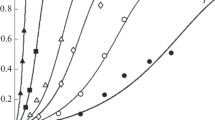Abstract
The solubility of carefully characterized magnetite, Fe3O4, in dilute aqueous solutions saturated with H2 has been measured at temperatures from 100 to 300°C in a flow apparatus. Solution compositions included either HCl or NaOH molalities of up to 1 and 40 mmole-kg−1, respectively, and H2 molalities of 0.0779, 0.779, and 8.57 mmole-kg−1. The dependence of the equilibrium solubility on the pH and reduction potential were fitted to a scheme of soluble ferrous and ferric species consisting of Fe2+, FeOH+, Fe(OH)2, Fe(OH) −3 , Fe(OH)3, and Fe(OH) −4 . Solubility products from the fit, corresponding to the reactions
and
were used to derive thermodynamic constants for each species. The extrapolared value for the Gibbs energy of formation of Fe2+ at 25°C is −88.92±2.0 kJ-mole−1, consistent with standard reduction potentials in the range Eo(Fe2+)=−0.47±0.01 V. The temperature coefficient of the equilibrium Fe molality, (∂m(Fe, sat.)/∂T)m(H2).m(NaOH), changes from negative to positive as the NaOH molality is increased to the point where Fe(OH) −3 and Fe(OH) −4 predominate.
Similar content being viewed by others
References
P. R. Tremaine, R. von Massow, and G. R. Shierman,Thermochim. Acta 19, 287 (1977).
F. H. Sweeton and C. F. Baes,J. Chem. Thermodyn. 2, 479 (1970).
G. A. Kanert, G. W. Gray, and W. G. Baldwin,The Solubility of Magnetite in Basic Solutions at Elevated Temperatures, Atomic Energy of Canada Ltd., Report AECL-5528 (1976).
I. Lambert, P. Beslu, A. Lalet, and J. Montel, inThermodynamics of Nuclear Materials 1979 (International Atomic Energy Agency, Vienna, 1979), paper IAEA-SM-236/12, in press.
M. A. Styrikovich, O. F. Martynova, I. F. Kobyakov, V. L. Men'skikova, and M. I. Reznikov,Therm. Eng. 19, 127 (1972).
I.-M. Chou and H. P. Eugster,Am. J. Sci. 277, 1296 (1977).
G. R. Helz, Ph.D. Thesis, Pennsylvania State University (1971).
D. A. Crerar, N. J. Susak, M. Boresik, and S. Schwartz,Geochim. Cosmochim. Acta 42, 1427 (1978).
P. R. Tremaine and J. C. LeBlanc,J. Chem. Thermodyn., in press.
G. K. Johnson and J. E. Bauman, Jr.,Inorg. Chem. 17, 2774 (1978).
H. Tamura, K. Goto, and M. Nagayama,J. Inorg. Nucl. Chem. 38, 11, 3 (1976).
J. Smiltens,J. Chem. Phys. 20, 990 (1952).
N. S. McIntyre and D. G. Zetaruk,Anal. Chem. 49, 1521 (1977).
Y. L. Sandler and R. H. Kunig,Nucl. Sci. Eng. 64, 866 (1977).
P. V. Balakrishnan,Can. J. Chem. Eng. 55, 357 (1977).
D. M. Himmelblau,J. Chem. Eng. Data 5, 10 (1960).
A. E. Harvey, Jr., J. A. Smart, and E. S. Amis,Anal. Chem. 27, 2, 6 (1955).
C. F. Baes, Jr., and R. E. Mesmer,The Hydrolysis of Cations (Wiley, New York, 1976).
W. L. Marshall,Inorg. Nucl. Chem. 37, 2155 (1975).
W. L. Marshall and E. V. Jones,J. Phys. Chem. 70, 4028 (1966).
G. Olofsson and L. G. Hepler,J. Solution Chem. 4, 127 (1975).
J. W. Larson, P. Cerutti, H. K. Garber, and L. G. Hepler,J. Phys. Chem. 72, 2902 (1968).
D. D. Wagman, W. H. Evans, V. B. Parker, I. Halow, S. M. Bailey, and R. H. Schumm,Selected Values of Chemical Thermodynamic Properties, U.S. Natl. Bur. Stand. Tech. Notes 270–3 (1968) and 270–4 (1969).
P. Schindler,Advances in Chemistry, R. F. Gould, ed. (Am. Chem. Soc., 1967), Vol. 67, Chapter 9.
K. K. Kelley and E. G. King,Entropies of the Elements and Inorganic Compounds, U.S. Bur. Mines Bull. 592 (1961).
E. D. Eastman and R. M. Evans,J. Am. Chem. Soc. 46, 888 (1924).
D. R. Stull and H. Prophet, eds.,JANAF Thermochemical Tables, Natl. Stand. Ref. Data Ser., U.S. Natl. Bur. Stand., Vol. 37 (1971).
K. K. Kelley,High-Temperature Heat Content, Heat Capacity, and Entropy Data for the Elements and Inorganic Compounds, U.S. Bur. Mines Bull. 584 (1960).
H. C. Helgeson and D. H. Kirkham,Am. J. Sci. 274, 1089 (1974).
S. W. Benson,Thermochemical Kinetics (Wiley, New York, 1968).
W. M. Latimer,Oxidation Potentials, 2nd edn. (Prentice-Hall, New Jersey, 1952).
W. A. Patrick and W. E. Thompson,J. Am. Chem. Soc. 75, 1184 (1953).
H. C. Ko and L. G. Hepler,J. Chem. Eng. Data 8, 59 (1963).
T. Hurlen,Acta Chem. Scand. 14, 1533 (1960).
E. E. Bernarducci, L. R. Morss, and A. R. Miksztal,J. Solution Chem. 8, 717 (1979).
R. E. Mesmer,Inorg. Chem. 10, 857 (1971).
B. O. A. Hedstrom,Ark. Kem. 5, 457 (1953).
D. L. Leussing and I. M. Kolthoff,J. Am. Chem. Soc. 75, 2476 (1953).
B. Shrager,Chem. News 138, 354 (1929).
K. H. Gayer and L. Woontner,J. Phys. Chem. 60, 1569 (1956).
Author information
Authors and Affiliations
Rights and permissions
About this article
Cite this article
Tremaine, P.R., LeBlanc, J.C. The solubility of magnetite and the hydrolysis and oxidation of Fe2+ in water to 300°C. J Solution Chem 9, 415–442 (1980). https://doi.org/10.1007/BF00645517
Received:
Revised:
Issue Date:
DOI: https://doi.org/10.1007/BF00645517




